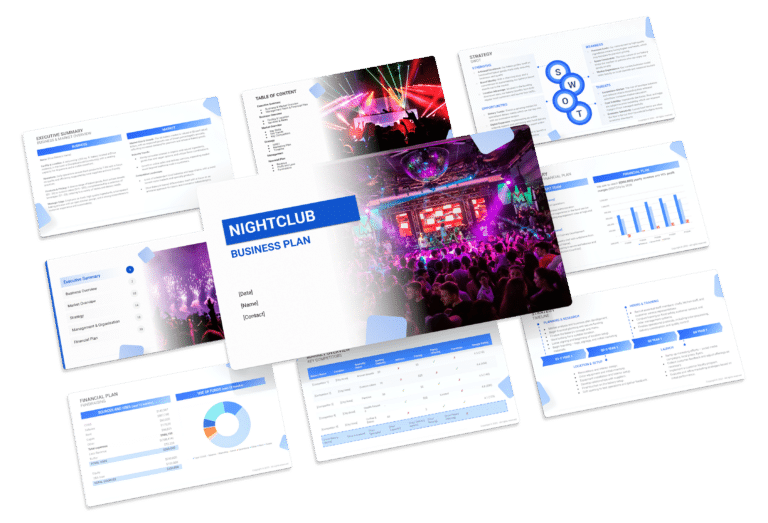SWOT Analysis for a Golf Course: Template & Example

A SWOT analysis is essential in crafting a robust business plan for a golf course. This analysis, which stands for Strengths, Weaknesses, Opportunities, and Threats, helps understand internal and external factors that can impact your business. Strengths and weaknesses are internal to the business, while opportunities and threats are external.
In this article, we’ll explore various examples of strengths, weaknesses, opportunities, and threats, aiding golf course owners in incorporating these insights into their business strategies.

Strengths
Highlight the strengths that set your golf course apart, ensuring a competitive edge and customer loyalty.
- Scenic Location and Aesthetics: A golf course situated in a breathtaking location with picturesque views and well-designed landscaping can attract golfers seeking a memorable experience.
- Example: Showcase the natural beauty of the course in promotional materials, emphasizing the serene environment and visual appeal to attract golfers looking for a unique golfing setting.
- State-of-the-Art Facilities and Course Maintenance: Providing exceptional facilities, impeccably maintained fairways and greens, and top-quality equipment can captivate serious golf enthusiasts.
- Example: Regularly communicate course maintenance efforts through newsletters or social media updates, highlighting the commitment to delivering an outstanding golfing experience.
- Varied Amenities and Services: Offering a wide array of amenities such as a clubhouse, pro shop, dining options, or professional instruction can attract diverse groups of golfers and enhance overall satisfaction.
- Example: Promote tailored packages that encompass lessons, memberships, or exclusive access to clubhouse amenities to cater to different golfer preferences.
- Established Reputation and Customer Loyalty: Building a loyal customer base through membership programs, personalized services, and a track record of delivering exceptional golfing experiences.
- Example: Create exclusive membership tiers with added perks to reinforce loyalty and foster a sense of belonging among members.
Weaknesses
Address weaknesses to fortify your golf course for sustainable success.
- Seasonal Dependence and Weather Vulnerability: Relying on specific seasons or weather conditions might lead to revenue fluctuations and operational challenges.
- Example: Introduce indoor facilities, host off-season events, or diversify services (e.g., offering event hosting or weddings) to mitigate the impact of seasonal fluctuations.
- High Operational Costs: Maintenance expenses, staffing requirements, and equipment costs can strain financial resources and affect profitability.
- Example: Explore cost-sharing initiatives with neighboring courses, implement efficient maintenance strategies, or optimize staffing during off-peak times to reduce operational overheads.
- Aging Infrastructure or Outdated Facilities: Outdated amenities or course design could discourage golfers from seeking modern experiences.
- Example: Consider periodic renovations or upgrades to maintain competitiveness and appeal to a wider demographic of golfers.
- Limited Marketing and Outreach Efforts: Inadequate marketing strategies or limited exposure might underutilize the golf course’s potential.
- Example: Invest in targeted marketing campaigns, forge partnerships with travel agencies, or collaborate with golf influencers to increase visibility and attract a broader audience.
Opportunities
Seize opportunities to expand and innovate on your golf course.
- Golf Tourism and Destination Marketing: Leveraging the course’s appeal to attract tourists and increase revenue through golf vacation packages.
- Example: Collaborate with local tourism authorities, hotels, and travel agencies to promote golf packages and entice tourists to visit the area.
- Technological Integration: Embracing technology to enhance the customer experience through online reservations, course navigation apps, or virtual course tours.
- Example: Develop an interactive app providing real-time updates, online tee time reservations, and personalized golfer guidance for an enhanced experience.
- Sustainable Practices and Environmental Awareness: Adopting eco-friendly initiatives to attract environmentally conscious golfers.
- Example: Implement sustainable practices and communicate these efforts through marketing campaigns to appeal to environmentally aware customers.
- Collaborations and Event Hosting: Organizing tournaments, charity events, or partnerships with golf professionals to increase visibility and attract diverse groups of golfers.
- Example: Partner with renowned golfers to host tournaments or clinics, attracting fans and aspiring golfers to the course.
Threats
Prepare for potential threats to ensure the resilience of your golf course.
- Economic Downturns and Spending Changes: Economic uncertainties impacting discretionary spending might reduce golf-related activities.
- Example: Offer flexible payment plans or discounted packages during economic downturns to attract budget-conscious golfers.
- Competition from Nearby Courses: Nearby courses offering similar or superior facilities may divert potential customers.
- Example: Conduct competitor analysis to differentiate offerings and focus on unique experiences or specialized services to stand out.
- Environmental Regulations and Land Use Policies: Changes in regulations impacting course expansion or maintenance practices.
- Example: Stay informed about regulatory changes, engage in community discussions, and adapt practices to comply with evolving environmental regulations.
- Weather-Related Challenges: Extreme weather conditions disrupt course conditions and operational continuity.
- Example: Invest in weather-resistant infrastructure, develop contingency plans, and communicate real-time updates to mitigate disruptions caused by adverse weather conditions.





